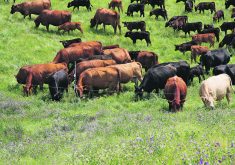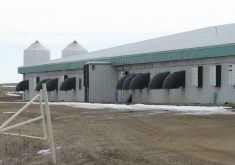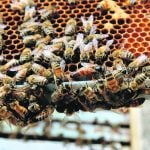File under C
I am writing in response to the article “Hail the Canadian canola board” by Russell Jeffrey in the March 16 edition.
It is astounding that the mere “exploring of marketing options” would drive Mr. Jeffrey to such lengths of apoplexy. Is it so terrible to even consider marketing options? If the present system is not working, isn’t it incumbent on any thinking person to consider alternatives? Is Mr. Jeffrey perhaps afraid of losing a lucrative business?
Unfortunately the whole article has a lot of questionable hypothetical conclusions or premises, the most fascinating one being that a canola board would “dictate prices to the Japanese, Chinese … “.
Read Also

Determining tariff compensation will be difficult but necessary
Prime minister Mark Carney says his government will support canola farmers, yet estimating the loss and paying compensation in an equitable fashion will be no easy task, but it can be done.
Shouldn’t someone be telling the CWB that as a single seller they could dictate prices? Silly me, I thought prices were largely a matter of supply and demand; after all Canada is not the only place where canola is grown.
As for the building of facilities and growth in employment, one has only to look at the CWB and the grains sector to see what actually happens.
What is really interesting is what has happened with the amalgamation and mergers in agriculture related industries. In spite of Mr. Jeffrey’s suggestions, the grain industry has many fewer elevators. Has this increase in efficiency translated into much lower elevation charges? Not where I do business.
Privatization of CN has brought the first train since Christmas to our local “high throughput” elevator. This elevator is no longer owned or operated by a co-op but by an efficient, private corporation. Who do you suppose is paying the salaries of the workers when they are underemployed?
I could go on, of course, dissing Mr. Jeffrey’s diatribe, but I fail to see any positive result and therefore suggest that this article be filed under the term “Comedic Fantasy” suitable for a publication such as Mad Magazine.
– Horst Schreiber,
Ohaton, Alta.
Downhill slide
Farmers, we must fight to keep the Canadian Wheat Board. If the CWB goes, we will go back to the prices in the 1930s. The freight cost more than the grain was worth. The big company Cargill and other companies in the U.S. will control the market.
If you think that the price of grain is low now, wait and see. When we let the Crow go, the farmers went downhill. Freight went from 30 cents per bushel to $1.35. My farm went to hell.
Right now at the price of grain we lose about $8,000 to $10,000 per quarter. We can’t make the cost of production now. We do not have a subsidy like the U.S. farmer. I know what I am talking about, 66 crops and still farming.
If we let the CWB go we can all walk away from the land.
– Jack Pawich,
Cartwright, Man.
Solo clarification
Re: Clarification on expectations of weed control from Solo herbicide.
In a previous article in the Western Producer (March 9), I was quoted during a presentation I made at a producer meeting held in North Battleford. During my talk, I made a short presentation on Solo herbicide. The reporter who covered the story quoted me accurately. However, based on feedback and comments from producers, I feel that some of my statements were misleading and I wish to clarify some points.
Solo herbicide contains the active ingredient imazamox. Imazamox is a component of Odyssey herbicide. Odyssey contains two active ingredients: imazamox and imazethapyr (the active ingredient in Pursuit). Imazamox is less residual than imazethapyr and that is why the company is introducing it to the marketplace. It is well suited to growers who want a herbicide that has a lower carryover potential and less re-cropping restrictions.
Imazamox (Solo) is a slightly better grass killer than imazethapyr and is generally not as strong on broadleaf weeds. However, a study that I conducted in 2005 showed that Solo and Odyssey provided similar broadleaf weed control in field pea. 2005 was an exceptional year for weed control due to excellent growing conditions. Our study showed that Solo and Odyssey provided more than 90 percent control of kochia due to superb growing conditions.
However, growers should not expect this level of control on a consistent basis. In most cases, both of these products will only suppress kochia (around 70 percent control). Neither of the products will control Group 2 resistant kochia, which is very common in parts of Saskatchewan. The quotes in the published article make it appear that growers can expect consistently high levels of kochia control. This is definitely not the case; growers should expect kochia control from Solo herbicide to be similar to or slightly less than Odyssey.
Expectations for wild buckwheat control follow a similar trend ….
I thank the Western Producer for giving me the opportunity to provide growers with a more accurate representation of how this herbicide performs.
– Eric Johnson,
Weed Biologist, Scott Research Farm,
Scott, Sask.
Scare tactics?
As I was paging through the latest Canadian Wheat Board propaganda publication, Grain Matters, I saw a headline, “Loss of single desk would cost $55 a tonne.” This sounded a little extreme, so I did a few calculations using those figures and the latest CWB pool return outlook.
The PRO for No. 2 CWRS wheat, an average grade, is $177 per tonne minus $52 backed off to our area, a farmgate return of $3.40 per bushel. Reduce that by the $55 per tonne, you’re left with a farmgate price of $1.90 per bu.
The CWB PRO for feed barley is $125 per tonne minus $49.50 freight and handling, leaves $1.64 per bu. Remove another $55 per tonne, you have 44 cents per bu.
The CWB PRO for 2006-07 is even worse. Using the same deductions feed barley would be 18.5 cents per bu.
I ask all you avid CWB supporters, do you really believe all that hogwash? How does the CWB come up with these figures? They hire a couple of socialist professors who know what kind of results the CWB expects. I would ask these two professors, how did you arrive at these conclusions? … No doubt you must use some new math system which I am not familiar with.
Over the last several years of barley sales, I have consistently received 50 cents to $1 per bu. above the CWB price from the open market. This year, all prices are below production costs but I still managed to get 30 to 40 cents per bu. above the CWB PRO.
Using scare tactics like that makes the CWB sound a lot like the former government in Ottawa.
– Roger Brandl,
Fort St. John, B.C.
Target price
There is all this hype by the government and the media to save the family farm. If this is true, then a decision has to be made to save family farms in Western Canada.
I believe the way to do this is to set a target price on the first 10,000 bushels of wheat grown at $10 a bushel. Therefore, every farm that grows 10,000 bushels would have a minimum of $100,000 income – not much with high fuel, fertilizer, and machinery costs.
I do not know how many farmers are left that grow 10,000 bushels or more in Western Canada. The subsidy or target price would cost number of farms times 10,000 times $6 a bushel. We are receiving approximately $4 now. After 10,000 bushels, the commodity a person grows would sell at the world price, no subsidy. Therefore if a person chooses to farm 20,000 acres, so be it, but he is on his own. He can grow other commodities besides wheat and market his produce as he sees fit. This would make the anti-wheat board people happy.
To grow 10,000 bushels, a farmer would not need a huge amount of land, therefore allowing more small and younger farmers to come back to the land. The small towns would hopefully grow, dealerships have more customers, and the city congestion slow down.
Europe has made it a social issue to leave people on the land. If our society and government do not want this, say so, and let’s accelerate the rural depopulation and train farmers to move to the city and get meaningful employment.
It baffles me that Canada follows the World Trade Organization rules and the Europeans and Americans do not.
– Rudy Ormann,
Foremost, Alta.
Dodo birds
What is the difference between a Saskatchewan and Alberta agriculture minister? Well, according to the articles in the Western Producer, the Alberta ag minister has chosen to lower the premium on their crop insurance, hail insurance, revenue insurance program this spring so that their farmers won’t have to go without protection because of cost. This move cost the government $20 million.
That same newspaper tells a different story here at home. The Sask. ag minister is not concerned that his farmers are paying off red ink in the crop insurance system for the last five years. That red ink was not our doing but our provincial government ignored the warning signs that the fund would run out. They chose not to put provincial and federal dollars into the fund.
No problem, we will raise the farmer’s premiums. Who cares if they can’t afford it? This province is smarter than Alberta. That is why we invested another $1.6 billion into biotech in the name of ag. Why do we lead the planet in technology and our dirt farmers young and old alike are going the way of the dodo bird? Like that same trusting bird, we farmers make the job of eliminating us very easy. Our silence is our approval.
This provincial government always complains it doesn’t have Alberta’s money. This NDP government also has chosen to embrace biotech crops that 90 percent of our grain customers don’t want or buy from any one.
The difference is in the future vision. West of us, the farmers’ problems are looked at and responded to….
So the future vision here is we will be eating biotech for breakfast and don’t worry if it makes you sick, that same company will have a pill to make you feel better.
Thank God Alberta has its feet on the ground and is listening to the pulse of its farmers….
– Randi Ellis,
Hazlet, Sask.
Wrong target
I was very angry when I read that the Good Spirit School Division (Yorkton, Sask., area) chaired by Ray Sass, is planning to take legal action against the rural municipalities who are withholding their education portion of the property tax. It seems they are contemplating legal action against the very people who pay their bills.
As a property taxpayer, I was encouraged by the leadership that the RMs undertook to right the wrong of unfair education tax based on land holdings. It was especially discouraging to hear the remarks from chairman Sass about the legal action, especially when everyone knew an announcement was forthcoming by the provincial government at the annual Saskatchewan Association of Rural Municipalities convention.
It would appear that the newly elected school board was trying to flex its muscles and show the land owners who was really in control. With approximately half the RMs supporting withholding the land tax funds, I wonder who they were playing to?
Perhaps if the board had used an ounce of wit they could understand that agricultural landowners are undergoing a substantial reduction in their “wages” and that restraint on spending is required. The legal action was a complete waste of money. …
I wonder what the school divisions now think of the RMs that banded together to get their point across. It would have been nice to see the RMs and school divisions working together to fix a common problem, rather than fighting.
Perhaps the only way to teach the directors the benefits of co-operation is to elect new ones next election.
– Darrell Dutchak,
Rama, Sask.
CWB action
The Canadian Wheat Board is still under attack by those who think they can do a better job of marketing their wheat and malt barley on their own. Of course, they do not speak for the majority of farmers in Western Canada.
If we examine what happened with the gun registry it is pretty easy to see that the minority will be successful in getting rid of the CWB. What are you doing to make sure that doesn’t happen? Are you writing letters to provincial and federal politicians telling them that you want to keep the CWB and why?
Wheat and barley are the only commodities which the CWB is involved in marketing. CWB critics would like us to believe that an open market would actually give us a better price for our wheat. If that is the case, then can these same people please explain why it is that canola, flax, oats and other farm commodity prices are in the gutter? Surely it’s not the fault of the CWB.
If we believe all the noise that these people are making, getting rid of the CWB would give us better wheat prices, yet it is quite clear that the open market system is not delivering better commodity prices.
The CWB has bent over backwards with a multitude of program choices to appease the farmers out there who must have full payment for their wheat the same day they take it off the field. Then there is always the choice to stop complaining and grow other crops. If they don’t think that the CWB is doing a good job for them why are they still seeding wheat? Stop complaining and seed something that pays more. …
For those who are being led to believe that selling your grain on the open market is a better choice, one has to consider if there really is an open market out there and who is controlling that market. Some economists have stated that once there are less than five players in a market system, such a system is essentially a closed market. …
I for one am not convinced that getting rid of the CWB would benefit my farm. I have taken action by writing this article. I will also be sending CWB support letters to provincial MLAs and federal MPs. That is truly the only way that CWB supporters are going to be able to keep the benefits of a strong wheat-marketing agency intact. …
The squeaky wheel gets the grease and the CWB issue is no different. If we want to keep the CWB we will have to make more noise than the other guys. Once it is gone it will be too late to make noise.
– Denis Sauvageau,
Falher, Alta.
African issue
I read with sorrow the Producer item March 2, “African farmers must change habits: experts.”
I have been to Africa about 20 times. I have been to more than a dozen African countries … for periods of a few days to some weeks. I am disgusted by the lack of honesty about Africa and by stupid campaigns and food aid supposedly intended to help the ordinary African people.
I have not encountered or heard any statement recognizing the most fundamental cause of Africa’s problems: too many children. And some religions are still urging their African adherents to have more children.
The average age for all the people in Africa is less than 16 years. A majority of children do not receive any significant education and therefore they lack the knowledge needed to be more productive in their work. …
Most national development assistance agencies have failed to insist that recipient countries live up to their obligations in development assistance agreements. As a result, too much development assistance funds have ended up in Swiss banks …
If Africa is to overcome its predominantly terrible problems, it should do as China, India and Thailand have done.
For the last decade those three countries have had a higher increase in GDP per capita per year than any other country in the world.
Four of the major factors enabling those astonishing achievements are:
1. Each of those three countries has had effective population programs promoting fewer babies per family.
2. That has enabled better education for the children they do have and the improved education has enabled children to be more productive when they enter the labour force.
3. Women and girls are not so repressed and exploited as in Africa so they have better health, are more efficient and capable in their work.
4. Instead of clinging to outmoded inferior farming practices, those three countries have aggressively adopted improved farming practices.
The campaigns to provide medications to relieve the effects of HIV may extend lives for some Africans but that does not increase or improve food production.
Traditional development assistance without fundamental improvements especially in agriculture and in population control will not solve the terrible problems in Africa. Without population control, the problems in Africa will surely increase. …
My personal financial assistance to Africa goes to assist high-level education of a very practical applied nature.
– C. F. Bentley,
Edmonton, Alta.
Formidable task
Directors of the Battlefords-Lloydminster constituency organization met every month over the past 10 years. We began as the Reform party, then the Alliance, and finally the new Conservative Party of Canada. We directed our efforts to informing Canadians of the effect of the Constitution Act of 1982.
The Trudeau Liberals passed it without public debate by use of closure. No one knew exactly what it meant. We know today.
It provided for a strong central government that could overrule the rights of the provinces. The freedoms of the individual that were inherent in our common law have been traded off for rights that are dispensed at the pleasure of the government.
Special rights may be granted to groups of people based on race, creed and culture and gender. Official bilingualism has been forced on all citizens, even in areas where it is not needed. The total cost has now reached over $750 billion.
Our democratic parliamentary system of government was placed in jeopardy. Our legal system is in a shambles. Our police forces can no longer maintain law and order. Corruption runs rampant in practically every department in Ottawa and the Liberal party itself is riddled with scams, kickbacks and fraud.
As directors, we have worked hard to formulate policies which answer these problems. Many of our ideas have reached the floor of our conventions for discussion and some have been adopted by our party. For this effort we have often been called racists and bigots and rednecks by Liberals and by eastern media.
Now that Stephen Harper is prime minister, we hope some of our ideas will become the law of the land. With a powerful Liberal opposition and Liberal appointed Senate and Liberal appointed bureaucracy he faces a formidable task.
Our next task is to work diligently to give him a majority in the House of Commons.
– John I. Fisher,
North Battleford, Sask.
Root ’em out
The Canadian Agri-Food Trade Alliance is a group of well organized corporate double crossers, knifing farmers in the back at every turn but having our governments and farmers believing they are doing great work for the farm problems, when in fact they created the damn problems.
I always wondered why or how come the Canadian Cattlemen’s Association had so much say about the removal of the Crow Rate.
And why has a good thing like the two-priced wheat system not been renewed? Where are you farmers that you don’t call for this? What’s wrong with you guys? All brainwashed, I guess.
Band together and fight for farmers. There is so much BS going on behind farmers’ backs that I guess it’s hard to sort out the bad guys from the good.
But I know the Western Canadian Wheat Growers Association gets backing from the Alberta government, if you can imagine. Barley Growers are about the same kind of help to farmers, but these are like false farm groups out to destroy anything good for real farmers.
These rotten organizations must be rooted out of plans by the government of Canada and exposed for what they really are.
Once ordinary farmers know this, they can surely think with a clearer mind and ideas that would be positive for the farming industry. It’s such a mess since the Free Trade Agreement and North American Free Trade Agreement. Farming back in the days of GATT (General Agreement on Tariffs and Trade) was a real pleasure. It must return to take the strife out of farming.
– R. Bohush,
Sherwood Park, Alta.
Truth seeker?
On Feb. 24 and 25 I attended a Canadian Wheat Board symposium in Regina. The agenda consisted of several excellent speakers who gave a history on the formation of the board, how it operates, the advantages of having it and the disadvantages of not having it.
All government MPs, opposition MPs and western MLAs were invited to come and get the facts. Only a few from Saskatchewan came.
Prime minister Harper appointed MP Chuck Strahl as federal agricultural minister. Mr. Harper later showed his extreme disdain for western farmers when he appointed anti-wheat board campaigner David Anderson, the MP for Cypress Hills-Grasslands, as Strahl’s parliamentary secretary with responsibility for the CWB file. It should be noted that 70 percent of the Canadian electorate voted against the Conservatives.
Mr. Anderson should have attended the Regina meeting or at least had a representative there if he was too busy to attend. It appears that he does not want truth to interfere in politics.
– George A. Calvin,
New Norway, Alta.
Too many rats
Hey, Canada, ever heard what happens with too many rats in a cage? You could also ask what happens with too many humans living in close quarters?
Compare big city crimes to rural area crimes. Murder is rampant in the huge cities and rare in rural areas. Doesn’t that answer the question quite nicely?
Yes indeed, there will always be city people who love the bright lights, the crowds, conveniences at their door, living in a postage stamp-sized yard, and all that other fun stuff. They absolutely love it all and you couldn’t take them away from it. Every whim or desire can be quickly gratified.
You will note that a lot of people who work in the city do not live in the city. They live in a small town within a reasonable driving time to work. Many want their children to live where big city problems won’t corrupt them.
Why, then, is our government so stuck on centralization and breaking farmers into moving to town? To stop crime, one would think governments would be trying to decentralize and keep people in rural areas. Rural schools, local hospitals, small garages and other small business would stay open and no one would lose their jobs. … Set up small sustainable farms that allow farmers to make a living and those farmers won’t need a secondary job either. Someone else can have it.
– S. Gaudet,
St. Louis, Sask.
















